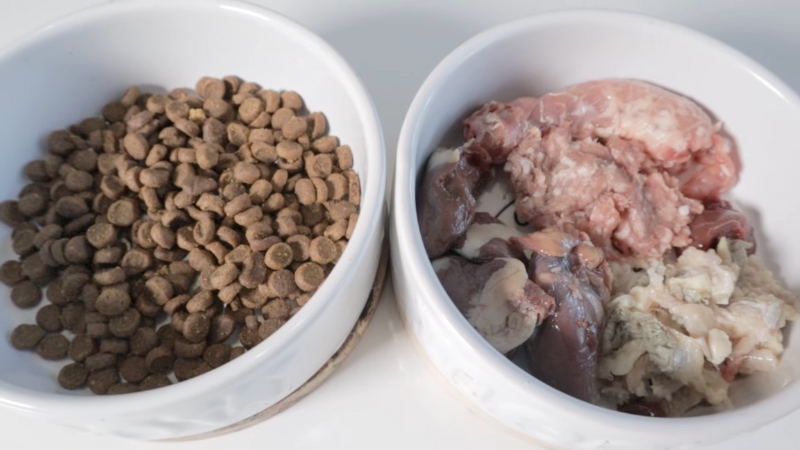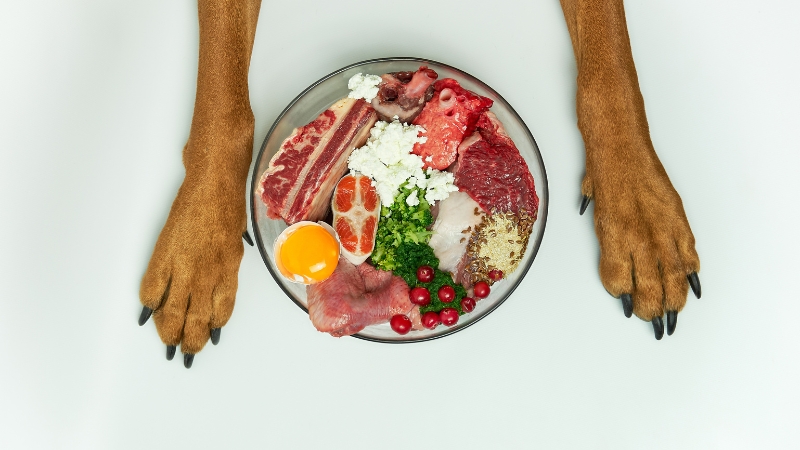Rotational feeding for dogs involves offering different types of food at various times. More vets now recommend this practice. It supports better nutrition and helps the digestive system.
It also keeps dogs interested in meals and reduces food sensitivity. This guide explains how to rotate food correctly and the benefits of doing so.
Why Vets Recommend Rotational Feeding
Dogs benefit from variety in their diet, much like people do. While many commercial dog foods claim to be complete, no single product can cover every nutritional need over a long period.
Proteins from different animal sources offer unique vitamins, minerals, and amino acids, which is why rotating between them can prevent deficiencies. Along with changing proteins, varying food textures can stimulate appetite and keep dogs interested in eating.
Most veterinarians agree that offering a diverse range of meals contributes to a more balanced and practical long-term feeding approach.
Over time, vets have observed clear improvements in dogs fed this way. Their skin becomes healthier, their coats glossier, and their energy more stable.
Many also find that dogs on a rotating plan experience fewer recurring health problems and respond better to new foods when dietary shifts are required. These outcomes are not anecdotal but are seen across various breeds and age groups.
In 2022, the American Holistic Veterinary Medical Association surveyed its members and found that 68 percent of holistic vets recommended or used food rotation as part of a general care strategy.
These vets noticed reductions in gastrointestinal issues and allergic reactions, especially in dogs with prior food sensitivities. Most structured dog nutrition plans that involve variety show stronger long-term results compared to fixed diets.
Feeding only one type of food for extended periods can create gaps that are not always immediately visible. Even premium brands may lack certain trace minerals or over-rely on specific ingredients.
A diet that includes a variety of food types over time helps balance those shortcomings. It also strengthens the digestive system by allowing the gut to adapt to various foods, thereby reducing the risk of stress or rejection when changes are necessary.
Benefits of Rotational Feeding
View this post on Instagram
Rotational feeding helps create a healthier digestive system by supporting the development of a broader range of gut bacteria. These bacteria play a crucial role in nutrient absorption, waste processing, and the functioning of the immune system.
By offering different food combinations, dogs are less likely to experience gas, bloating, or sudden changes in appetite, and more likely to develop steady eating habits.
Many dog owners who switch to rotation diets notice noticeable changes in their dog’s behavior and physical condition. Dogs often have more energy, play longer, and appear more alert.
Coats tend to become shinier and softer, and stools more regular and consistent in texture. Mealtime can also become something the dog looks forward to, which can help reduce picky eating and meal refusal.
Introducing different proteins through rotation also helps reduce the likelihood of food allergies. A 2021 study published in the Journal of Animal Physiology found that dogs consuming a single protein source for extended periods were at a higher risk of developing allergies.
By switching proteins regularly, the immune system remains calm, and the body is less likely to treat certain foods as threats. This reduces symptoms like itching, chronic ear infections, or stomach distress.
Dogs accustomed to variety are also more adaptable in unpredictable situations. If a particular product becomes unavailable due to a recall or shipping delay, dogs that are already accustomed to multiple food options are less likely to reject new ones.
This flexibility is essential for travel, boarding, or emergencies, where adhering to a single type of food may not be feasible.
Dog Food Rotation Guide

Many dog owners want to know how to begin. Start by picking food types: dry, wet, cooked, or raw.
Then, choose proteins such as chicken, beef, turkey, lamb, or fish. Stick with each new option for one or two weeks before moving to the next.
Rotation Schedule Example
Week
Food Type
Protein Source
1-2
Dry
Chicken
3-4
Wet
Beef
5-6
Cooked
Lamb
7-8
Raw
Turkey
Switching to a new dog food safely means adding the new food gradually. Start with 25% new and 75% old. After two days, shift to half and half. Then 75 percent is new.
After about a week, use only the new food. This helps prevent stomach upset and allows you to identify any food sensitivities that may be present.
Why Rotate Dog Food Proteins
@sayitoncedogtraining Do you rotate your dogs meat? How many people have been told you should feed your dog the same kibble every day for the rest of their life, and that changing the food is bad for the dog. Think of how crazy that sounds when you say it out loud. I have seen a huge difference since switching to fresh food from @PetPlate ♬ original sound – Say It Once Dog Training
Using the same protein for too long can create food intolerance. Symptoms may include itching, vomiting, or loose stools. Rotating proteins prevents overexposure. It also builds muscle, improves skin health, and supports a shiny coat.
Each protein brings its benefits. Chicken gives lean protein and essential amino acids. Beef adds iron and zinc. Fish supports joint function through omega-3. Lamb supplies vitamin B12 and selenium. A complete dog diet requires all of these nutrients over time.
Other proteins, such as duck, venison, and rabbit, offer alternatives for dogs with common sensitivities. Duck contains healthy fat and B vitamins.
Venison is low in cholesterol and rich in iron. Rabbit is easily digestible and often used in allergy-friendly diets. Including less common proteins broadens nutrient coverage and supports long-term variety.
Protein rotation also reduces the load on specific organs. For example, excessive consumption of red meat can strain the liver in dogs with sensitive systems. Balancing white and red meats enables the digestive system to recover and function more effectively.
Feeding Dogs Different Brands
Some owners worry about mixing food brands. But giving dogs different brands can be safe when done with care. Each brand offers its blend of vitamins, meat types, and food textures. This improves the range of nutrients and keeps meals interesting.
Different manufacturers source ingredients in unique ways. One brand might use pasture-raised beef, another may use ocean-caught fish. Switching brands can enhance food quality by incorporating a variety of protein and mineral sources. It also provides dogs with various formulas that support joint health, skin care, or weight control.
Food variety helps digestion. A 2023 report by the Pet Food Institute found that 61 percent of dogs showed improved digestion when rotated through multiple formulas. Textures also matter. Crunchy food helps teeth. Wet food increases hydration. Raw bones strengthen the jaw.
Dogs with a history of food boredom often start to eat better when rotated across different brands. Even picky dogs usually enjoy new smells and textures that come with a brand shift. Owners who frequently rotate brands report an increased appetite and greater meal excitement.
Vet-Approved Dog Feeding Methods

Vets support rotating food if it follows a structured plan. They do not recommend random food changes. A clear dog nutrition plan includes trusted brands, slow ingredient changes, and attention to how your dog responds.
Many veterinary clinics now offer feeding schedules that include protein rotation, brand variation, and seasonal shifts. This mirrors the way dogs would naturally eat if they had access to different sources of food throughout the year.
Vets often recommend rotating between grain-free and grain-inclusive formulas. This avoids overloading on legumes or starches. It also balances fiber levels, which supports regular bowel movements and optimal nutrient absorption.
Puppies can start rotation early. Many clinics include a rotation guide in their care programs. Adult dogs also benefit when changes are made slowly. Consult a veterinarian if your dog has a history of allergies or stomach issues.
Rotation also prepares dogs for emergencies. In times of food recalls or shortages, dogs that are accustomed to variety adjust better to substitutes. Dogs that only eat one brand or flavor are more likely to refuse alternatives during urgent changes.
Signs Your Dog May Need Rotation
Sign
Possible Cause
Boredom with meals
Lack of variety
Itchy skin
Protein sensitivity
Gas or bloating
Digestive stress
Constant ear infections
Food intolerance
Refusal to eat
Repetition of the same flavor
Low energy
Incomplete nutrient intake
Loose stool
Poor digestive adaptation
Common Misconceptions
Some human foods can actually be harmful to dogs, leading to serious health issues.
Watch this video to learn 5 toxic foods that you should never give to your dog. 🚫🍫https://t.co/96YpopNPyJ— Heads Up For Tails (@huftindia) March 5, 2024
Some people think rotating food causes stomach issues. That can happen if changes are made too fast. A slow switch avoids most problems. Others fear new foods may be unsafe.
However, trusted brands adhere to strict safety standards.
Many believe dogs need routine. In reality, most dogs enjoy new tastes. Adding variety to your food can bring interest and mental stimulation. It also reflects how dogs naturally eat.
Wild dogs eat a wide range of meats and textures each day.
Another myth is that rotational feeding is more expensive. In truth, rotating affordable options often helps keep costs steady.
Many owners save money by utilizing bulk deals from multiple brands or taking advantage of seasonal sales. Rotation can also reduce future vet bills by improving overall health.
Bella the Rescue Dog
Bella had lived in a crowded shelter for months. Her fur was dull and falling out in places. Her ribs were visible, and she shied away from people and food bowls alike.
She had stopped trusting food, people, and the routine of daily care. When Elena brought her home, she knew it would take time and patience to help Bella feel safe again.
Elena noticed right away that Bella would not eat anything dry. She walked away from her bowl every time.
Elena collaborated with a veterinarian to develop a gentle transition plan to help Bella adjust to a healthier diet. They began with soft, home-cooked turkey and mashed vegetables. The warmth and texture helped Bella take her first few bites.
Once Bella tolerated the soft food, Elena added wet lamb stew to her meals. It had a rich smell and a smooth consistency. For the first week, she mixed a small amount of lamb into the turkey. Bella sniffed, hesitated, then slowly ate the whole portion. Her confidence grew as she learned the food was safe.
Within a month, Bella’s coat looked fuller, her eyes had more light, and her energy began to return. She stopped scratching at her ears and stomach.
Elena gradually added dry beef kibble and small portions of raw chicken. Each change was tracked in a notebook. Every meal became a learning moment for both of them.
Today, Bella eats a full rotation of dry, wet, and raw meals. She has favorite textures and flavors. She wags her tail when Elena reaches for the food container. She waits at her spot in the kitchen before each meal, relaxed and ready. Food no longer feels like a threat.
The change in Bella goes beyond nutrition. Her relationship with food healed her relationship with routine. Elena says that feeding variety helped Bella trust again. What started as a feeding plan became a turning point in Bella’s recovery. With each new bowl, Bella regained part of herself.
Tips for Starting Rotational Feeding

Begin with two food types. You can start with wet and dry meals. Add one new protein at a time. Watch your stool, skin, and energy levels. If anything looks off, slow down the change.
Use a notebook or a meal tracking app to record your meals. Write down what your dog ate and how they reacted. Add probiotics if needed. Dogs may drink more or less with different foods. Always offer clean water.
Rotate only one element at a time. If you change both brand and protein in the same week, it becomes hard to track reactions. Stick with one variable so you know what works and what causes problems.
Include seasonal rotation. During colder months, some owners supplement their dogs’ diets with more calorie-dense food.
In warmer months, they switch to lighter meals with higher water content. This keeps dogs comfortable and supports their energy needs.
Final Thoughts
Rotational feeding supports long-term health. It reduces food boredom and related issues. It fits how dogs eat in natural settings.
Most dogs benefit from variety. Rotate food types, change proteins, and watch your dog’s reactions. Always use quality brands. Consult a veterinarian when starting or changing your pet’s plan.
Dogs require a balanced diet for optimal energy and health. A rotating diet helps achieve that balance. It is simple, practical, and makes a real difference.







